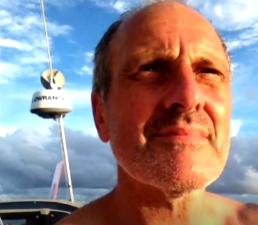 Canadian Bert terHart recently completed a 267-day solo, non-stop circumnavigation of the world via the five capes on his 43′ sailboat using only traditional celestial navigation. He is the first North American to circle the globe solo and non-stop using only a sextant, a chronometer, an almanac, pen, paper, and charts with which to navigate.
Canadian Bert terHart recently completed a 267-day solo, non-stop circumnavigation of the world via the five capes on his 43′ sailboat using only traditional celestial navigation. He is the first North American to circle the globe solo and non-stop using only a sextant, a chronometer, an almanac, pen, paper, and charts with which to navigate.
While not using global positioning satellites to navigate, he did bring along an email equipped satellite phone and posted to a blog and an Instagram account. In addition to maintaining contact with friends and family, he was also followed online by about 2,000 children from Kenya to New Zealand to New York from their classrooms.
“I wanted to engage kids in something that really would stretch their imagination,” he said.
When he departed Victoria, British Columbia, there was no pandemic. He said that hearing about the spread of the virus around the world from the isolation of his boat was surreal.
The Global News quotes terHart saying, “It was really hard because there’s nothing you can do.”
“You’re not at risk in any way, of course — I’m at risk of the elements and the weather, but I’m prepared for all that … you’re literally a thousand miles away from anyone, even if I wanted to help, it would take a month to get there.”
On his return to British Columbia, Canadian authorities agreed to waive the mandatory two-week quarantine period for arriving visitors on the basis that a solo-circumnavigation was sufficient self-isolation to prevent the spread of the virus.

I guess he just ignored the equipment he has installed?
We can see the antenna in the photo.
@phil – that’s a radar radome.
I missed the adventure 🙁
It probably saved me a lot of worry and stress 🙂
Thank you for this article.
May I just put in a word for Joshua Slocombe who did this in 1895?
He was born in Nova Scotia, which according to my very old, 1970s, atlas was in North America.
“I had resolved on a voyage around the world, and as the wind on the morning of April 24, 1895 was fair, at noon I weighed anchor, set sail, and filled away from Boston, where the Spray had been moored snugly all winter. The twelve o’clock whistles were blowing just as the sloop shot ahead under full sail. A short board was made up the harbor on the port tack, then coming about she stood to seaward, with her boom well off to port, and swung past the ferries with lively heels. A photographer on the outer pier of East Boston got a picture of her as she swept by, her flag at the peak throwing her folds clear. A thrilling pulse beat high in me. My step was light on deck in the crisp air. I felt there could be no turning back, and that I was engaging in an adventure the meaning of which I thoroughly understood.”
Great reading and inspiring for any yachtsman.
And that before Instagram and all the other “social media” bull. His book about it became a best seller which no doubt “Bert erHart” laughed at whilst looking at his AIS, EPIRB, VHF selcall, satellite weather predictions etc etc etc.
It all comes down to definitions. Joshua Slocum was the first person to sail around the world alone. It took him three years and he made many intermediate stops. Bert terHart is claiming the title of first non-stop solo North American circumnavigator using traditional celestial navigation. So, there are at least three qualifiers to his assertion. Nevertheless, he made it around the globe alone.
Our Cape Horner Jan Wit a Dutchman did this in 1989 he left and arrived Falmouth he carried a 12 meg VHF radio to speak to ships, he was spoken 5 times in 273 days at sea. Jan said he wanted to do this in the old way. By the way he and his father in law built the yacht in the garden out of steel. No internet then!
We at http://www.capehorners.org welcome new member applications from those who race and those who do not but cruise be it yacht or square rigger.
Remembering the traditions of the old ways
Chris CH archivist
@Albert Pasay, I’ve also seen GPS that looked just like that.